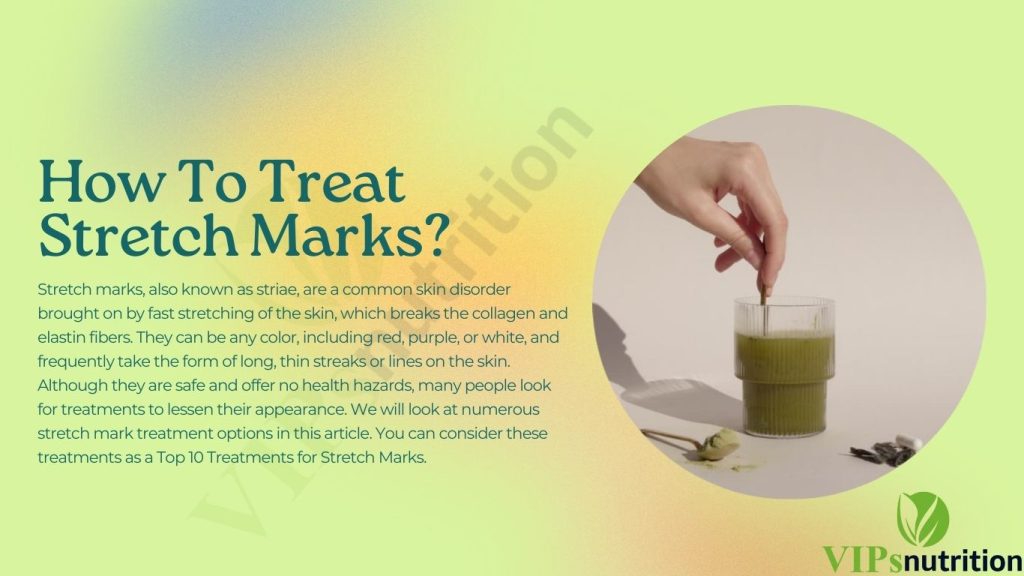Stretch marks, also known as striae, are a common skin disorder brought on by fast stretching of the skin, which breaks the collagen and elastin fibers. They can be any color, including red, purple, or white, and frequently take the form of long, thin streaks or lines on the skin. Although they are safe and offer no health hazards, many people look for treatments to lessen their appearance. We will look at numerous stretch mark treatment options in this article. You can consider these treatments as a Top 10 Treatments for Stretch Marks.
- Topical creams and lotions treatment for stretch marks: A range of over-the-counter creams and lotions may make stretch marks less obvious. These products usually contain ingredients like retinol, hyaluronic acid, collagen, vitamin E, and cocoa butter. Although results may vary from person to person, these creams and lotions can help to improve the suppleness, texture, and hydration of the skin. It is essential to use them frequently and follow the provided instructions.
- Creams prescribed by a dermatologist: In more serious cases, a doctor may recommend harsher creams or ointments containing chemicals like tretinoin (a vitamin A form) or a mixture of specific acids. These prescription lotions can perhaps aid in the fading of stretch marks by enhancing collagen and cell growth. However, because of possible adverse effects and safety measures, they should only be taken under physician supervision.
- Cosmetic procedures: Cosmetic operations, Several cosmetic procedures might lessen stretch marks’ appearance, albeit they might not entirely get rid of them. These comprise:
- Chemical peels: During a chemical peel, a chemical solution is administered to the skin, causing the skin to exfoliate and eventually peel off. Stretch marks could be less noticeable as a result of this.
- Microdermabrasion: During this procedure, the skin’s outer layer is exfoliated using an instrument with a rough surface or tiny crystals. By removing the dead skin cells, microdermabrasion can reduce the appearance of stretch marks and promote the creation of new, healthier skin. It can take numerous sessions to observe any noticeable changes, despite the technique normally being safe and non-invasive.
- Laser therapy: Stretch marks can potentially be made less visible using laser treatments. Depending on the type of stretch marks, various lasers, such as pulsed dye lasers or fractional lasers, may be employed. The skin’s texture and color are enhanced by the laser radiation, which also encourages collagen synthesis. It can take several sessions, and the outcomes will depend on the specifics.
- Microneedling: A device with small needles is used during the microneedling technique, also known as collagen induction therapy, to induce regulated micro-injuries in the skin. These micro-injuries encourage the synthesis of collagen and elastin, which aids in skin regeneration and lessens the visibility of stretch marks. Microneedling can be carried out at home with dermarollers or in a dermatologist’s office, but professional procedures are typically more efficient.
- Platelet-rich plasma (PRP) therapy: PRP therapy includes removing a tiny amount of platelet-rich plasma from the patient’s blood and injecting it directly into the affected areas. Stretch marks might be less noticeable because platelets carry growth factors that might encourage collagen and tissue healing. The need for more sessions may arise based on the outcomes.
- Radiofrequency treatments: The deep skin layers are heated during radiofrequency (RF) treatments, which also tighten the skin by encouraging the creation of collagen. Stretch marks can be less noticeable and skin texture can be improved with RF therapy. For better results, it is frequently coupled with other treatments.
- Surgical interventions: Abdominoplasty (tummy tuck) or laser-assisted liposuction may be explored in extreme circumstances. To lessen the appearance of stretch marks, these operations either entail removing the damaged skin or tightening the surrounding tissues. They are often saved for particular circumstances because they are intrusive and have some dangers.
- Chemical peels: Chemical solutions are applied to the skin during chemical peels, causing the skin to exfoliate and shed its outer layers in a regulated manner. Stretch marks may become less noticeable as a result of this process, which encourages the creation of new skin cells. Home use is possible for superficial peels, but a qualified expert should perform deeper peels.
- Self-care and lifestyle changes: Despite not being direct therapies, some self-care routines and lifestyle adjustments can improve the health of the skin in general and possibly lessen the visibility of stretch marks. Maintaining a nutritious diet full of vitamins, minerals, and antioxidants; drinking plenty of water; using sunscreen to protect the skin from too much sun exposure; exercising frequently to increase blood circulation; and refraining from smoking, which can impede the production of collagen and slow healing.
It’s crucial to remember that the effectiveness of stretch mark treatments might vary based on the age, color, and severity of the stretch marks as well as the specific skin characteristics of the patient. Additionally, compared to earlier, white stretch marks, some therapies might work better on recent, red stretch marks. It is advised to consult a dermatologist or skincare expert to choose the best course of action based on your unique circumstances and objectives.
In conclusion, stretch marks may not be totally reversible, but there are a number of treatment alternatives that can help minimize their appearance. These therapies range from less intrusive techniques like topical creams and lotions to more invasive ones like laser therapy or surgery. Self-care routines and lifestyle modifications can also improve the general health of the skin. To choose the best course of action for your particular circumstance, you must speak with a healthcare practitioner.

